Amazon Fire Phone Early Reviews TepidAmazon Fire Phone Early Reviews Tepid
Early reviews of Amazon's first smartphone won't send consumers rushing to buy. Did Amazon miscalculate on key features?


Amazon Fire: 6 Key Points
Amazon Fire: 6 Key Points (Click image for larger view and slideshow.)
Amazon's first smartphone, the Fire Phone, goes on sale Friday for $199. According to the initial wave of reviews, most consumers would be better served buying a different device. The biggest complaints center on the usefulness of Dynamic Perspective and Firefly -- what Amazon considers to be the phone's best traits. Reviewers also dinged the Fire Phone's battery life, user interface, and design. Is the Fire Phone a flop in the making?
Amazon is taking a huge chance with the Fire Phone. At $199 with a contract, it costs the same as the Apple iPhone 5s, Samsung Galaxy S5, HTC One, and LG G3 -- all made by established players with years of experience. The full retail price of the Fire Phone is $650, but AT&T is pushing customers to sign contracts. Further, the device is locked to just one carrier and can't be used on competing networks. With premium pricing and limited availability, one would expect the device to at least compete in terms of performance. It doesn't.
[Grab your time machine. See Smartphones Of The Future: 6 Cool Technologies.]
The two big leaps of faith for Amazon are Dynamic Perspective and Firefly. Dynamic Perspective uses four user-facing sensors to track head placement. It uses the data to generate a 3D user interface that requires users to tilt the phone back and forth to see certain aspects of the UI. The problem, say reviewers, is that Dynamic Perspective doesn't always work and is slower than simply touching the screen.
"It's a neat trick, but, in my tests, I found that I tired of it, partly because you have to flick the phone just right to make the panels appear, and then again to dismiss them," wrote Re/Code's Walt Mossberg. "Call me impatient, but after too many frustrating flicks I resorted to swiping the side panels open and closed, even when I was using the phone one-handed, because I found it quicker and surer."
Reviewers found Firefly similarly flawed. Firefly makes use of the Fire Phone's camera to take pictures of physical objects and then search for them. Firefly appears to work well with packages, barcodes, and clear text, but fails often enough to cause frustration. "Firefly can recognize lots of things, but it's incredibly, hilariously inconsistent," said The Verge's David Pierce. "It's not nearly accurate as it needs to be."
Nearly all the reviewers faulted the Fire Phone's blocky, simple design. It doesn't have the elegance or refinement offered by the iPhone 5s or HTC One, nor the killer screens of the Galaxy S5 and G3. The Fire Phone scored points for one-handed use, but the smaller 720p HD screen didn't impress.
Battery life problems plagued The Wall Street Journal's Geoffrey Fowler. Fowler said he couldn't get the Fire Phone's battery to last a single day, despite testing two different review units. "The biggest reason I wouldn't switch to a Fire is its battery, which like the iPhone is sealed inside and can't be replaced," wrote Fowler. "The phone usually died after about three-quarters of a day's ordinary use -- calling, surfing, emailing, mapping, and listening to music -- and often got warm to the touch."
Perhaps the biggest condemnation comes from PCMag's Sascha Segan, who likens the device to a storefront. "Amazon's Fire Phone doesn't solve any real consumer problems. It's fun, well-built, and filled with interesting gimmicks, but it's ultimately designed as a giant Buy Now button for Amazon services."
This is likely the only reason Amazon decided to jump into the smartphone market in the first place. The company has realized a certain degree of success with its Kindle Tablets, which are great for consuming books, music, and movies. Amazon makes it as simple as possible to make those content purchases on its tablets, and the Fire Phone takes it a step further with Firefly. One could make the argument that tablets are used more recreationally and sporadically than smartphones, which accompany us throughout our day. By putting a Buy Now button in our pockets, Amazon has lowered the barriers of consumption even further and clearly hopes device owners will make purchases more frequently.
Based on the first reviews, however, there is little incentive for consumers to make the leap to Amazon's Fire Phone. If the device can't compete in the basics, let alone successfully execute its supposed best features, few people will find Amazon's Fire desirable.
information's new Must Reads is a compendium of our best recent coverage of the Internet of Things. Find out the way in which an aging workforce will drive progress on the Internet of Things, why the IoT isn't as scary as some folks seem to think, how connected machines will change the supply chain, and more. (Free registration required.)
About the Author
You May Also Like






